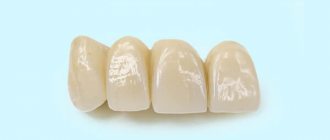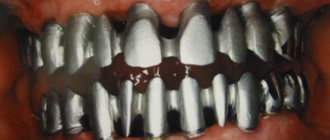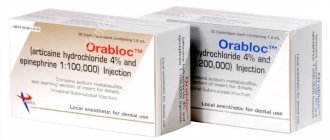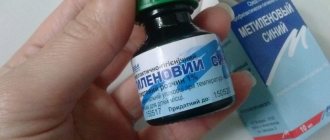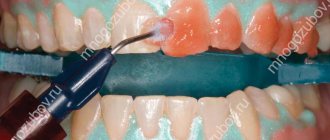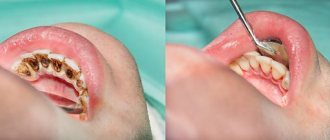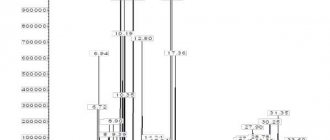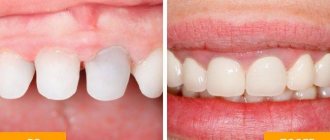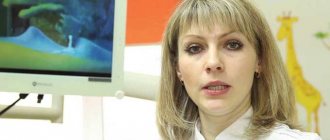Beautiful, even teeth, a correct bite—many adults dream about this, and they dream about this, since they have to pay tidy sums for special orthodontic procedures and braces in adulthood. This can be completely avoided if you take care of bite and other problems with improper growth of teeth and jaws in childhood. When the maxillofacial bones have not yet been formed, the gums are quite soft, and the replacement baby molars can be easily corrected, that is, from the ages of 6-7 to 12 years, children's dental plates are used. They need to be curled and tightened from time to time, but these simple procedures will provide your child with a perfect smile throughout adolescence and adulthood.
Types of designs and their features
It is important to understand that different types of plates are used today to straighten teeth. According to their purpose, they are removable and non-removable, for the upper and lower jaw, also double-jawed or monoblock (for example, the Andresen-Goipl apparatus).
Fixed plates
In children 6-10 years old, a non-removable Ross plate can be installed, designed to expand the upper dentition. As for adults and children over 12-14 years of age, braces that are fixed if they have a permanent bite work most effectively for them. The braces also contain small plates with grooves or clasps, which are attached to each individual tooth using special glue, and then connected to each other with a metal arch.
True, calling bracket systems plates, as many sources on the Internet do, is incorrect. This is a separate type of orthodontic appliance.
Removable devices
But for children with mixed occlusion aged from 7-8 to 12-14 years, this type of orthodontic structures, such as plates, is most often recommended. These are removable devices that are characterized by an increased level of comfort, facilitate hygienic care, and can be removed from the mouth while eating food. We list the most common options in this category:
- plate without active elements: suitable for correcting minor malocclusion pathologies, for example, correction of one incisor or canine,
- replacement plate: preserves space on the jaw and prevents bite pathologies if some milk teeth were removed much earlier than the expected eruption of permanent teeth. Its design may include artificial teeth to temporarily replace lost ones. They may also be non-removable, depending on the individual clinical situation,
- Frenkel function regulator: this is a technically complex design that uses both jaws at once. There are four types of Frenkel apparatus: for the treatment of neutral, distal, mesial and open bite. Among other things, they help rid the child of harmful functional habits (for example, improper breathing) that contribute to the formation of pathologies. Some experts believe that it was on the basis of these devices that modern trainers were created,
- Brückle apparatus: fixed on the lower jaw, but allows you to correct the position of the upper teeth due to its design features,
- devices with an expanding spring: the spring itself can have different shapes, for example, serpentine,
- plates with an active orthodontic screw: fixed to the upper and lower jaw. This is one of the most common options used in orthodontics to correct the position of teeth during the period of mixed dentition. And this is exactly what is meant when patients are interested in how to tighten a dental plate. This, of course, does not mean that all other devices cannot be adjusted, but this option can be adjusted independently, naturally, under the strict guidance of a doctor and according to an individually designed schedule.
For adults
Adults rarely play records, since they are usually useless here. If the defect is mild, the use of such a device is still allowed. However, it is large, and the effect on aesthetics is even worse than braces and the discomfort from them is much greater.
If you want to correct your bite, but do not accept fixed appliances, it is recommended to use aligners. These are transparent removable aligners. Such devices are comfortable, unnoticeable, and useful for not too large dental defects.
It is better for adults to use aligners
Important ! An adult will have to use orthodontic plates for at least a year. And how much exactly will be determined by what defect the bite has.
Video - About aligners for straightening teeth in Question-Answer format
The design of devices that can be twisted
Before answering the question of how to properly tighten a dental plate, you need to understand what it consists of and how it is structured. Let's look at the structure of the standard design in more detail:
- a plastic base, usually consisting of two mirror parts: it accurately follows the anatomy of the palate and jaw. Moderately hard, but still quite durable. It can be of any color, most often it has bright tones, which children like and allows them to adapt faster,
- clasps or ring fasteners: these are small wire hooks located at the edges of the device. As a rule, they are fixed on molars,
- arc: made of metal. It acts in exactly the same way as a power arc, which is fixed in the grooves of braces - it puts pressure on the dentition in order to move them in a given direction,
- orthodontic screw with holes: a plate for straightening teeth has such an element in the center of the base. It will then need to be tightened, or more correctly, untwisted or activated. For what? To change the size of the device, correct pressure on the jaws and teeth,
- marking colored arrow indicating the direction of movement of the screw.
What does an orthodontic screw in plates look like and what is it for?
In general, an orthodontic screw or lock is a factory-made mechanical element that is included in many orthodontic plates. It is usually made from stainless steel.
There are different types of screws, different in size, shape, and purpose - some are used only in structures for the upper jaw (Bertoni, Steiner). Many of them are capable of working in several directions at once: moving individual teeth, symmetrically and asymmetrically expanding, narrowing or lengthening the base of the apparatus in order to influence the dentition.
Screws are made up of several threaded pins and have a thickening in the center called a barrel. There are holes in the drum - through them the plate is activated with a special key, which the orthodontist gives to the patient after installing the device.
Appearance of the record
Any plate consists of a relatively rigid base, which exactly follows the relief of the hard palate, and a metal wire arch that fixes the teeth in a certain position. Some types of plates are additionally equipped with clasps, screws or springs.
Such structures are made from high-quality hypoallergenic materials without harmful chemical impurities. The base of the plate is plastic, and the hooks - clasps, arches and the correction mechanism are made of a nickel-titanium alloy, which is durable and lightweight. Therefore, parents do not need to worry that their child carries the record in his mouth all day long.
Indications for wearing screw devices
As a rule, they are prescribed during the period of active change from a temporary bite to a permanent one. At this time, the jaw bones are still quite soft and pliable, and therefore it is possible to adjust the growth of the jaws if, for example, the upper one is too narrow and does not keep up with the lower one, or vice versa. Plates are often prescribed when there is a need to increase or decrease the size of the palate or straighten crowded and crooked teeth.
They are also used in a complex of therapeutic measures (before surgery) to restore the functionality of the maxillofacial apparatus in patients with cleft[1] of the alveolar process.
On a note! Sometimes plates of this type are used in adults. For example, if you need to change the location of one or more teeth, with minor bite pathologies. Or in addition to other methods of orthodontic correction. Often, at the final stage of treatment.
Useful tips
Because orthodontic plates are foreign bodies, the child may want to have them removed. Parents should keep this under close control. They must explain to their son or daughter that wearing this unpleasant device for a long time is required so that the teeth later look smoother and more beautiful.
If your child removes the plates frequently, the results will be delayed and they will have to wear them longer. The child should carefully monitor dental hygiene, brushing them twice a day. The plate must be removed during the procedures.
Important ! The device must be treated daily with one product, and weekly with another.
It is important to process the record daily
How to make and install a plate with a screw
Each design with a screw is individual. The appliance is created using impressions of the patient’s jaws in a dental laboratory, which usually takes 1-2 weeks. Before installation, it is important to undergo oral sanitation. That is, remove all bacterial plaque from teeth and gums, cure caries and get rid of other infectious and inflammatory processes, if any.
Installation of the device takes no more than 10 minutes: first, the clasps of the device are fixed on the teeth, after which the orthodontist lightly presses the plastic part so that it falls into place.
Installation price
Even the most expensive orthodontic plate is two or three times cheaper than the cheapest brace system.
How much you will have to pay for such a service depends on the locality in which it is carried out.
The cost of installing plates depends on the clinic
The average cost in the Russian Federation is approximately 10,000 rubles.
When is the orthodontic device activated?
There is no need to worry about how to tighten the plates for your child’s teeth. After installing them, the orthodontist will tell you everything and show you everything. But it is important to consider that the first activation of the systems does not occur immediately after their fixation, but only after 7-14 days - this period is necessary for the child to adapt (get used to) the orthodontic apparatus.
On a note! Activation is carried out by unwinding the drum located in the center of the orthodontic screw located on the plate. To carry out the manipulations, you need to use a special key, which the orthodontist will definitely give you.
Many people are interested in how often teeth plates are tightened. After the first activation, subsequent activations must be carried out according to an individually designed schedule. At first this is done quite rarely - on average once every 2-3 weeks. Due to this, the load on the jaws and teeth increases gradually, and the base of the plate gradually expands. Then the periods of tightening become more frequent - once every 7-14 days. At the final stage of treatment, activation is performed every 3-4 days.
Record care
For full treatment, you need to wear the plates constantly, removing them only during meals and before bed. In order for the structure to last as long as possible, it should be properly cared for.
· Before the next fixation, the plate should be washed under running water.
· Clean the structure in the morning and evening with soft toothbrushes, using special gels or regular toothpaste.
· Once a week, the record should be soaked overnight in cleaning concentrate, and if necessary, use deep cleaning products.
It is advisable that parents supervise the process of wearing and caring for dental plates. If used irregularly, the treatment process may be prolonged and its effectiveness may decrease. In addition, with poor oral hygiene or errors in the care of the structure, additional dental problems may arise, for example, the development of caries, plaque deposits and tartar formation.
How to tighten a screw correctly
As noted above, the teeth straightening plate has an orthodontic screw in the center. How to tighten this screw? The procedure is carried out using a special thin wire key, which is inserted into the screw hole and turned in a given direction - it is indicated by a colored arrow next to the screw, marked on the plate. It is important to understand that all manipulations with the structure are carried out only after you or the child remove it from the mouth.
It is important to know not only about how to properly tighten the plate for the upper and lower teeth, but also about some other nuances:
- the screw can be turned at different speeds,
- one turn occurs when the key is turned all the way: this frees up to 0.25 mm of space,
- to make a new turn, the key must be removed and inserted into the screw hole again,
- the number of revolutions is determined individually based on the clinical situation,
- if you have gone a little overboard, then this should not be scary, because there is always the opportunity to turn the mechanism in the opposite direction.
Important! The key must be removed from the screw hole parallel to the device. This is done with ease, and not with pressure, since otherwise you can return the system to its original position.
“At the appointment, the doctor explained everything to us in detail about how to tighten the plate for the teeth. My son had it installed on his upper jaw. Everything turned quickly. True, I didn’t trust my son with this task; I always did it myself, which in principle is not difficult. There was a case when we were leaving for the dacha and forgot the key at home, so we had to use improvised means to activate it. A paperclip arrived. Of course, I don’t recommend doing this on an ongoing basis, otherwise the device will break, but temporarily it can help someone out...”
Alina Karimovna T., review from gidpozubam.ru
The first activation is carried out by an orthodontist. Responsibility for subsequent twisting falls on the child or his parents. Every 1-2 months you should also bring your child to the doctor to monitor the progress of treatment.
Possible difficulties
During the process of expansion and twisting, patients may encounter the following difficulties:
- Lost or broken key. This part is quite small, so it often happens that it gets lost in the process. This is not fatal, since the key can be easily replaced with any sharp object: a needle, knitting needle, awl, straightened paper clip, etc.
- Record breakage. This situation during twisting rarely happens, mainly with plates for the lower jaw, since the plastic base in them is smaller in area. In this case, you need to go to the dentist as soon as possible without trying to repair the plate yourself, since improper repair can lead to negative consequences. The orthodontist will assess the size of the damage and advise you on what to do next: send the existing structure for repair or order a new plate.
Features of getting used to structures
Immediately after installing the plates, many patients feel slight discomfort, which, depending on individual characteristics, goes away after 30 minutes for some, and persists for several days or even weeks for others.
During the adaptation period, the child may feel pressure on the teeth, minor pain, friction and irritation in the soft tissue area where the plastic part of the device fits tightly. Diction may also be slightly impaired, a lisp may appear, salivation may increase, and difficulty swallowing saliva may arise.
Expert opinion
Vagapov on How and when to tighten a dental plate
Specializations:
Experience:
“After the first and subsequent activations of the orthodontic screw, discomfort may occur again, but it is less prolonged and not as pronounced as after installation of the system - most patients stop experiencing discomfort after 5-10 minutes.”
Benefits of dental plates
Dental plates, like every orthodontic design, have a number of advantages.
· Fast production.
Typically, no more than a week passes from the moment the impression is taken to the first installation.
· Safety.
The plates are made of hypoallergenic high-quality material.
· Easy care.
It just involves regular cleaning.
· Affordable price.
Dental plates are a budget option for correcting malocclusion and other dental anomalies.
The disadvantages of this design include only a longer treatment period compared to the use of braces.
